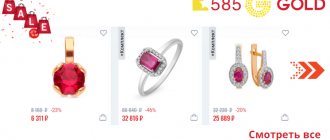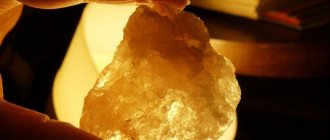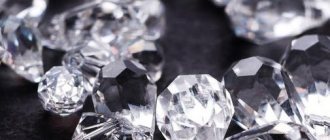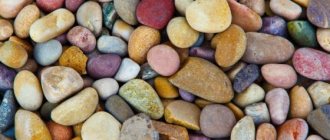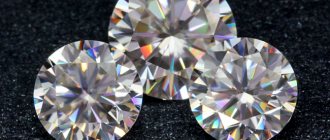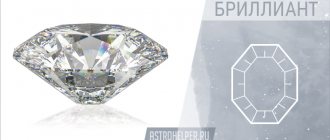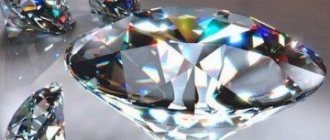Since the diamond is the most valuable of the stones, the rest of the colorless stones are oriented towards it. Most often they are called imitation diamonds. But achieving the same properties as a diamond is very difficult. What stones can be classified as a “diamond substitute”?
What makes a diamond so beautiful? A parameter such as light refraction is responsible for the radiance of the stone: the higher the dispersion, the more beautiful the colors play. Dispersion is the property of a stone to refract wavelengths of radiation at different angles, similar to a phenomenon such as a rainbow. An important factor is the hardness of the stone. Harder stones can be cut, which allows them to fully reveal their qualities.
Moissanite
White sapphire
In mineralogy, only the blue variety of the mineral is called sapphire; all the others, with the exception of ruby, are called corundum. White sapphire is a colorless, pure form of aluminum oxide and does not contain the oxides of other metals that color corundums in various shades.
The white variety of sapphire is used as a diamond imitation, or rather, a reasonable alternative to an expensive diamond. This very diamond-like stone is second only to diamond in hardness - 9 on the Mohs scale. The stone is almost impossible to damage. Unless, of course, you deliberately scratch it with industrial diamond or corundum.
Short story
The first reports about the production of artificially grown diamonds began to reach the world scientific community at the end of the 19th century, but most of them were false.
Ring with artificial diamond
The resulting crystals, unlike natural ones, had a different chemical composition, did not consist of carbon and did not have the properties of diamond, which primarily include:
- the maximum hardness among all known substances is 10 according to Mohs;
- high thermal conductivity;
- high light dispersion;
- low thermal expansion;
- chemical inertness;
- low friction coefficient;
- high electrical resistance.
Simply put, diamond is the world’s hardest dielectric (a substance that does not allow current to pass through), which heats up very quickly, but practically does not expand when heated.
Natural diamond is an inert substance that does not react with alkalis and acids under normal conditions.
At high temperatures, diamond flares up and burns, turning into graphite soot.
Ironically, diamond is made of carbon, the same substance as graphite, which has a Mohs hardness of 1. The properties of diamond are due to a different atomic structure.
For the first time, real diamonds were produced in Sweden in 1953. The diamond synthesis technologies invented then were based on reproducing the natural conditions for the formation of this mineral. It was necessary to recreate high pressure and temperature - 60 thousand atmospheres and 1.5 thousand degrees Celsius - to obtain the ideal diamond structure.
Production technologies
Currently, true man-made diamonds, which are cut into diamonds, are grown using two main methods. They are called HPHT and CVD methods, respectively.
The first name is an English abbreviation, translated as “high pressure, high temperature.” This method can be used to obtain crystals of regular cubic or dodecahedral shape.
The essence of the method: a workpiece made of graphite and a specially selected low-melting metal is placed in a structure of several multi-ton presses, squeezing it from all sides and simultaneously heating it. The metal melts, graphite dissolves in it, excess metal is removed, and with further compression a diamond is formed.
The disadvantage of this method is that the same installation can only produce crystals of the same size and shape.
The high temperature and pressure processing method is used for industrial diamond stamping.
CVD stands for “chemical vapor deposition.” The meaning of the phenomenon is the growth of a diamond film on a hydrogen-carbon workpiece. Significantly lower pressure and temperature are required here.
Using the chemical deposition method, you can obtain both colorless diamond and other colors by adding inclusions of certain metals to the gas chamber.
After the process is completed, the result requires polishing and cutting, but in this way you can even get an artificial black diamond.
Black artificial diamonds
There are a number of more exotic methods for producing synthetic diamonds, for example, synthesis by detonation of explosives containing carbon and ultrasonic treatment - ultrasonic cavitation.
However, these methods can only produce nano- and microcrystals that do not reach even one carat. They are used in industry, for example, for the manufacture of diamond-coated cutting tools.
Only 2-3% of all diamonds obtained at a factory or laboratory are cut as diamonds and used for jewelry. The bulk of synthetic crystals is taken by industry.
Nevertheless, a jewelry fashion arose for jewelry with hand-made diamonds. It spread mainly among Greenpeace followers.
Artificial Crystal Colors
Diamonds produced using the CVD or HPHT method are most often either colorless or have a blue or yellow tint.
These colors are obtained by introducing boron (blue) or nitrogen (yellow) into the reaction. It is difficult to grow a completely colorless diamond of high purity due to the large amount of nitrogen in the atmosphere. The record was set in 2015, and the weight of the resulting crystal was just over 10 carats.
Colorless artificial diamond
An artificial diamond is called grown, not synthetic, because its chemical composition, properties and characteristics are completely identical to natural ones. Synthesis methods imply a different structure of the resulting samples.
The market for grown diamonds operates legally.
A rule is gradually being introduced - on products with natural stone substitutes grown under artificial conditions, an appropriate mark is placed using laser engraving, which contains the name of the manufacturer and the serial number of the diamond. This practice has already been introduced by the US manufacturing company Gemesis.
You can distinguish an artificial diamond from a natural one using special testers that examine the stone in ultraviolet, infrared or x-rays.
Their spectrum reveals a small amount of nitrogen or metal impurities that are not typical for the creations of nature.
White Topaz
White topaz, a natural semi-precious stone, aluminum silicate, with a hardness of 8 on the Mohs scale, is considered relatively weak by jewelers. It has a strong glass luster with a slight pearlescent tint. A well-cut stone looks like a real diamond. In jewelry, only a specialist can distinguish them.
Transparent sapphire and topaz are not imitations; rather, they should be called analogues of diamonds.
The use of high-tech diamonds in jewelry
Despite the fact that moissanite has appeared quite recently, it is already popular not only as an analogue of diamonds, but also as a completely independent stone with excellent jewelry characteristics, which are found only in diamonds of the highest standard. The development of technology leads to the fact that soon people will learn to control the appearance of colored diamonds in a high-tech way, which will lead to the birth of a new era in jewelry. And the possibility of replacing natural stone with artificial diamonds will sooner or later reduce the market value of jewelry and make it more affordable.
Already, in terms of its aesthetic characteristics, laboratory diamond has no equal and does not look like an imitation.
Faceted moissanite deserves a setting made of the most expensive precious metals, as it sparkles and shimmers no worse than diamonds. A special optical effect of radiance and depth can be achieved in frames made of white gold, platinum and silver. Skillfully cut moissanite looks noble in rings, necklaces, bracelets, earrings and many other jewelry. Its luxurious shine, compared to “more evening” diamonds, is revealed at any time of the day.
Almost all cities of the world, including Moscow, have embraced beautiful jewelry with artificial diamonds such as moissanite. The variety of jewelry is so great that it satisfies the tastes of the most demanding customers.
Moissanite
Moissanite is a crystalline form of silicon carbide. Rarely found, it is usually found in or near meteorite craters. Almost all moissanite used in the jewelry industry is an artificially produced mineral.
Because of its hardness (9.5 on the Mohs scale), this imitation mineral is the closest thing to diamond in terms of durability. The stone looks similar to a diamond, but is very different from it in optical properties.
Moissanite outshines diamonds. I'm not kidding. The stone reflects light perfectly. The dispersion coefficient of moissanite is significantly higher than the dispersion coefficient of diamond. A beam of white light is decomposed into monochromatic rays of the entire spectrum of the rainbow. The stone shimmers like the lights of a neon advertisement, and this slightly vulgar shine immediately reveals the imitator. However, many people often refer to moissanite as a man-made diamond.
For lovers of glamor without the epic price tag of six months' salary, this is the perfect stone.
What is an artificial diamond
Creating synthetic diamonds is a complex process. It is difficult to reproduce in the laboratory the natural conditions under which a mineral is formed in nature. Perhaps this is why numerous attempts to obtain such a stone as an artificial diamond ended in failure.
The first mentions of experiments to invent a worthy replacement for a transparent crystal date back to the 19th century. In 1823, the scientist and engineer V. Karazin made the first successful attempts to create a gem similar to a diamond.
The official date of “birth” of the diamond analogue is considered to be 1905. The surrogate saw the light of day thanks to the efforts of the French scientist Henri Moissan. As a result of the experiments carried out by the researcher, a crystal of silicon carbide was obtained. Natural crystals are characterized by small sizes, so the fake was far from perfect.
However, the resulting substitute was found to be most similar in properties to natural diamond. The stone was named after the inventor - moissanite. Over time, scientists managed to synthesize larger specimens.
A substitute for natural diamonds obtained in laboratories these days, moissanite, is known as carborundum. Artificial crystals are made from natural silicon carbide, which is heated to 2400 degrees. In the production process of the substitute, iron is also used, which plays the role of a metal catalyst.
Diamonds are grown in a laboratory using carbon-containing substances.
This is, for example, graphite or coal. The classification of artificial crystals (HPHT diamonds and CVD diamonds) depends on the production method.
The size of stones grown in the laboratory does not exceed one carat. The production of large samples is not economically profitable, since such gems will be expensive. Nevertheless, successful attempts have been made in our country to grow crystals of larger sizes.
Cubic Zirconia
The zirconium dioxide crystal, first synthesized in the cubic system in 1970 for the needs of the optical industry, immediately attracted the attention of jewelers for its potential as a diamond simulator. In the Soviet Union it was called cubic zirconia, the technology was developed by scientists from the Physical Institute of the Academy of Sciences. In the West, the stone is called zirconium, zirconite and is designated by the abbreviation CZ.
Artificially grown from a melt in laboratory conditions in unlimited quantities and at an affordable price, the crystal immediately received the apt definition of “a diamond for the people.”
Today it is one of the most popular diamond substitutes. It can be found in products of famous jewelry brands and mass producers of luxury jewelry.
The stone has optical properties very close to the optical properties of diamonds. But not only these unique properties have contributed to the widespread use of cubic zirconium in jewelry. The stone is fantastically cheap: cubic zirconia weighing one carat costs about $20 on the world market. The growth technology is such that the crystal growth rate ranges from 8 to 10 mm/hour.
The main difference between cubic zirconia and diamond is its hardness, which is 8.5 on the Mohs scale. The stone is easily damaged and wears out quite quickly and loses its shine. In terms of specific gravity, cubic zirconium is much heavier than diamond.
Only an experienced connoisseur can visually determine which stone in jewelry, zirconium or diamond. Artificially grown crystals are always flawless, they do not have defects that are often found in natural gemstones. This, by the way, is the main express analysis used by jewelers. Comparing diamond and cubic zirconia does not require lengthy and complex analyzes. If the gemstone looks like a diamond but is flawless and perfect, it is undoubtedly cubic zirconia.
The leader in use for the manufacture of stylish jewelry with ultra-modern design is zirconium. A stone in jewelry can look both elegant and brutal, depending on the size and color of the crystal.
The technology for growing cubic zirconia crystals has been improved over the years to such an extent that the color of the crystals varies from transparent to black.
Artificial Diamond Colors
Crystals formed in natural conditions are distinguished by a rich color palette. This cannot be said about artificial stones. The colors here are not so varied. Despite this, the color of each synthetic mineral is attractive in its own way:
- The most popular color of grown diamonds is white. Externally, such crystals are more similar to natural diamonds than others. However, the process of producing stones is accompanied by difficulties. After all, you need to constantly monitor the conditions in which the mineral is grown. If foreign substances get inside, the shade of the imitation will change, which will affect the market value. Such crystals usually weigh no more than a carat.
- Yellow stones are easier to grow than white ones. The range of shades ranges from bright lemon to rich yellow. Such tones are obtained due to nitrogen impurities. There are synthetic diamonds with a fiery orange color. The weight of yellow gems reaches 2 carats.
- Blue colored stones show shades ranging from heavenly to deep blue. This diversity is achieved through the use of boron in the growing process. Typically, synthetic blue diamonds weigh 1.25 carats.
There are also other colors of artificial stones. Grown black diamonds, for the production of which nickel is used, are famous throughout the world.
Pomegranate
Colorless crystals are not found among natural garnets. But synthetic varieties of minerals can be created in laboratory conditions with any given color characteristics.
All colorless garnet crystals are artificial and are used in jewelry as an analogue of a diamond. It is mainly used in earrings, necklaces, pendants and pendants, since garnet is much softer than diamond - the hardness of synthetic garnet ranges from 7.5 to 8.5 on the Mohs scale. Its advantage as a diamond simulator is its luster: the colorless variety of the mineral has a diamond luster.
Where are synthetic diamonds in demand?
Often artificial stone causes a negative attitude. Still, this is a fake, not a real diamond, and supposedly such specimens are much worse than the originals. This is a bias for which there is no basis. An analogue of a diamond obtained in a laboratory has the same properties as the original. The scope of use of simulations is quite extensive:
- One of the advantages of a surrogate is durability. This makes it possible to use such diamonds in the field of high technology. The stones are used to create microcircuits and chips.
- The strength of the artificial analog allows the use of crystals for the production of drilling rigs, tools and equipment for cutting and grinding, and especially durable materials.
- Synthetic stones that have not been processed have found use in the medical field . They are used in medical equipment.
- Artificially created diamonds are a popular raw material in jewelry . Jewelry made from these stones is not inferior in brilliance and luxury to products made from natural gems.
Rutile
Rutile is a natural mineral, pure titanium dioxide. Belongs to the category of semi-precious and ornamental stones. There is a developed industry for the production of a synthetic analogue of rutile. Colorless variations of the stone are not found in nature, but in laboratory conditions it is easy to grow a crystal without impurities. Sometimes used as a diamond simulator.
It is a fairly soft mineral, with a Mohs hardness of 6.0-6.5. Such hardness is considered insufficient for jewelry inserts in expensive metals, since even dust particles can leave scratches on them with strong friction. Rutile crystals are usually used in the production of costume jewelry for the mass consumer.
Other substitutes
The simplest and cheapest diamond substitutes are made of glass. Of course, their quality varies greatly depending on the manufacturer, but, nevertheless, even Swarovski crystals cannot be compared in quality to diamond.
Since the beginning of the 20th century, technologies have been developed that have made it possible to make sapphires and rubies. For a time, colorless sapphires were also considered as diamond substitutes, but they are dull in color.
1) Another diamond substitute is rutile, which hit the market immediately after World War II. It is titanium oxide, a polycrystalline and opaque stone. It is made to look like a diamond by melting it down and removing impurities. The main thing is to know the right technology. The resulting crystals have a refractive index close to that of a diamond and even greater dispersion. But the strength of rutile is very low, which makes its processing difficult and the resulting stones short-lived.
2) Fabulite is a stone that also has characteristics close to diamond and is strontium titanate. Its main disadvantage is the same as that of rutile - it is too weak and brittle.
3) Yttrium aluminum garnet. This stone is superior in strength to the previous two, but, like a diamond, it is tired of it in terms of brilliance and color play, since it has noticeably lower indicators such as dispersion and light refraction. This garnet is obtained synthetically and has a low cost. Mainly used as an ornamental stone for making, for example, rhinestones. This stone is famous for being used to create a replica of Elizabeth Taylor's diamond. Moreover, the stone was made of such high quality that they could only be distinguished using special equipment.
4) Gallium-gadolinium garnet has lower strength, but light refractive index and dispersion are closer to diamond. Almost never produced for the needs of the jewelry industry, the main use is electronics. Much more expensive to produce than the previous one.
5) Zircon is the only stone that, due to its basic characteristics, can be confused with a diamond, which is also widespread in nature. It is distinguished by low hardness - 6.5-7. A good cut gives these stones a very attractive appearance and makes them very similar to diamonds.
6) The last stone is sheelite. It has good performance, but low hardness. It is not used as a diamond substitute because it is rare in nature.
Creating stones in the laboratory - fake or not
Diamonds created artificially from synthetic materials are incorrectly called copies. This is due to the fact that identical materials are used for their manufacture, but they are obtained in different ways. A real diamond and a fake differ in that in the first case the mineral is born in nature, and in the second it comes from human hands.
You may be interested in: What is a necklace? Jewelry for women made from natural stones
Artificial stones have all the properties of real diamonds:
- high strength;
- ability to conduct heat;
- identical resistance indicators;
- pronounced shine;
- characteristic structure;
- same refractive index.
You may be interested in: Garnet stone: description with photo, properties, who is suitable for it
The only difference between a fake diamond is that it does not have any defects. Due to this feature, they are used both in jewelry production and in industry. According to statistics, no more than 20% of natural stones are suitable for use in jewelry. The remaining 80% have cracks, inclusions, and cloudiness. If you use high-quality materials when creating synthetic stones, it is very difficult to distinguish a natural stone from a fake, even with modern equipment.
Durability of diamonds compared to other stones.
When it comes to durability, diamond is the undisputed leader. Very few gemstones can even come close to it in terms of structural hardness. Why is the hardness of a stone so important when choosing, for example, a ring? The softer the stone, the more likely it is to be scratched, chipped or even shattered by impact, for example. If the stone is not hard, then the edges of its edges, exposed to time, will gradually wear off. So, if you select a stone below 7 on the Mohs hardness scale, you risk that it can be easily scratched and abrasions may form on it. For everyday wear, such as a ring, a diamond is best. For jewelry that will be worn from time to time, you can purchase another precious and less expensive stone.
What colors are fake stones?
Natural diamond imitation is a complex and lengthy process. Therefore, today counterfeits are obtained in special laboratories. Many consumers are interested in how wide the color range of synthetic stones is. Unfortunately, the choice is so small that it is limited only to blue and yellow shades.
Along with this, transparent “diamonds” have always been more popular, but their creation requires a lot of time and effort. The process of obtaining colorless stones is complicated by the fact that scientists must constantly monitor the process and prevent boron or nitrogen from entering the composition.
To obtain artificial blue diamonds, bromine is used (it is added at a certain stage of production). The shade can vary from a thick, rich tone to a light, barely perceptible shine. Yellow stones are “grown” with the addition of nitrogen. Sometimes they also make black diamonds. In this case, nickel is used.
